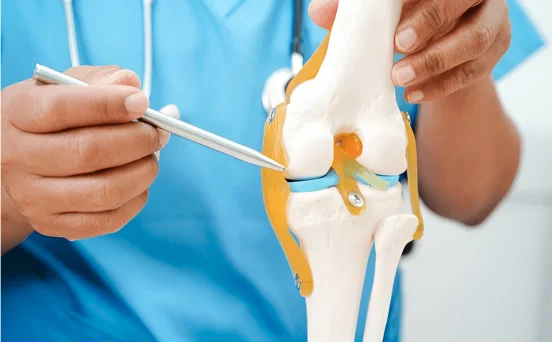The patellar realignment procedure is a specialized orthopaedic procedure that corrects the misalignment in the kneecap. Understanding what is patellar realignment surgery is essential for those seeking relief. This procedure is recommended when nonsurgical treatment fails to relieve chronic pain, instability or frequent dislocations. This surgery is crucial in restoring stability to the knee, preventing further joint damage, and improving overall quality of living.
Why do you need a patellar realignment surgery?
understanding of what is patellar realignment surgery
The patella, a small bony structure that is located in front of your knee joint, moves up and down as you bend or straighten the leg. As the knee bends and straightens, it moves up and down a groove on the femur called the trochlear grove. In a healthy joint, the patella moves smoothly in this groove. In some cases, however, the patella can shift or dislocate because of trauma, anatomical irregularities or muscle imbalances.
Common conditions leading to realignment surgery:
-
Patellar instability
-
Chronic Patellofemoral Pain Syndrome (PFPS)
-
Maltracking the kneecap
-
Congenital or developmental alignment issues
-
Cartilage damage due to repeated dislocation
-
Physical therapy or bracing treatments that fail
Patellar Realignment Symptoms
Not all knee problems require surgery. Some symptoms may indicate that a patellar realignment is necessary, particularly if they persist after conservative treatment.
The following symptoms are common:
-
Dislocations and subluxations of the patella repeated
-
The sensation that the knee is “giving way”
-
Pain when performing an activity, especially squatting or stairs
-
Swelling, inflammation
-
Instabilities or misalignments that are noticeable
-
Reduced range-of-motion in the knee
-
Grinding or clicking sounds
Your orthopedic specialist will likely recommend imaging tests, such as X rays, MRIs or CT scans, to determine the alignment and structure in your knee joint.
Different types of Patellar Realignment Techniques
Different surgical techniques are used to realign patellas depending on severity and the cause of misalignment.
1. Medial Patellofemoral Ligament (MPFL) Reconstruction
The MPFL is a ligament which holds the kneecap in position. This procedure is common when ligament damage leads to instability.
2. Tibial Tubercle Transfer (TTT)
This surgery, also known as Fulkerson Osteotomy involves repositioning of the tibial tubercle (where the tendon attaches to the patellar joint) in order to better align the patella and reduce the stress on the joint.
3. Lateral release
This technique involves cutting the lateral structures tight to allow for more natural movement of the kneecap within its groove.
4. Trochleoplasty
This surgery is for patients who have a shallow or irregularly shaped trochlear grove. It reshapes it to fit better with the patella.
Depending on anatomical requirements, each technique can be used alone or in combination.
What to expect during the Surgical Procedure
The procedure can last between 1 and 2 hours. The procedure can be done using open surgery or techniques , depending on its complexity.
The following are surgical steps:
-
Evaluation of patellar anatomy and tracking
-
Procedure for realignment (e.g. MPFL reconstruction or tibial tubercle osteotomy).
-
Stabilization using screws or anchors as needed
-
Wound Closure and Dressing
Depending on the procedure performed and the patient’s overall condition, patients may be discharged after a single day stay or an overnight stay.
After-Surgery Recovery & Rehabilitation
The recovery process after a patellar realignment can be a slow one and may take from 3 to 6 months, depending on the type and extent of the surgery and your individual healing response.
Recovery Timeline
-
Week 2: Pain Management, Icing and Elevation; Use of a Knee Brace and Crutches.
-
Week 2- 6: Start gentle range of motion exercises and physical therapy.
-
Weeks 6-12 Strength-building, weight-bearing is tolerated.
-
Month 3 to 6: Resumption of low-impact activity and gradual progression into sports.
It is important to adhere to your physical therapy plan in order for you knees’ strength, stability and mobility.
Benefits of Patellar Realignment Surgery
Surgery can provide life-changing results for patients who have persistent patellar misalignment or instability.
The following are some of the key benefits:
-
Improvements in knee alignment and function
-
Reduction of the risk of patellar dislocation
-
Reduced chronic pain, inflammation and swelling
-
Ability to perform daily and sports activities enhanced
-
Preventing long-term joint damage
Risks and Complications
The patellar realignment procedure is not without risks. However, they are rare if performed by a skilled orthopedic surgeon.
Risks include:
-
Infection of the surgical site
-
Blood Clots
-
Nerve or blood vessels injury
-
Leg stiffness or restricted motion
-
Nonunion or Hardware Irritation
-
Recurrences of instabilities
Following post-operative instructions and discussing these risks with your surgeon can reduce complications.
Who is a good candidate?
If you:
-
If you have frequent patellar dislocations, or instability
-
Non-surgical treatments did not provide relief
-
Image shows anatomical or malalignment abnormalities
-
You are committed to rehabilitation and in good health.
Patients with chronic tracking problems of the patellar tend to see great results following surgery. However, older adults can also benefit from this procedure if there is minimal joint damage.
Conclusion
Patellar Realignment Surgery can be a highly effective option for people who suffer from chronic kneecap instabilities, maltracking and pain. Modern surgical techniques and structured rehab programs can help patients achieve significant improvements in their knee function and overall quality of life.
Consult an orthopedic surgeon if you or someone else you know has recurring knee problems or a patellar dislocation to determine if this is the best option.























